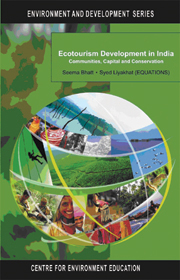Book contents
- Frontmatter
- Contents
- About the Authors
- Preface
- 1 Tourism and Ecotourism – General Introduction
- 2 International Legal and Policy Frameworks
- 3 National Legal and Policy Frameworks
- 4 Ecotourism: Voices of Dissent
- 5 Ecotourism: Some Successful Initiatives
- 6 Analysis and Discussion
- 7 Towards Sustainable Ecotourism
- 8 Ecotourism: Grounds for Protest
- 9 Ecotourism: Glimpses of Successful Initiatives
- Bibliography
1 - Tourism and Ecotourism – General Introduction
Published online by Cambridge University Press: 05 November 2011
- Frontmatter
- Contents
- About the Authors
- Preface
- 1 Tourism and Ecotourism – General Introduction
- 2 International Legal and Policy Frameworks
- 3 National Legal and Policy Frameworks
- 4 Ecotourism: Voices of Dissent
- 5 Ecotourism: Some Successful Initiatives
- 6 Analysis and Discussion
- 7 Towards Sustainable Ecotourism
- 8 Ecotourism: Grounds for Protest
- 9 Ecotourism: Glimpses of Successful Initiatives
- Bibliography
Summary
Tourism
Urry (1990) states, ‘Tourism is a leisure activity which presupposes its opposite, namely regulated and organised work. It is one of the manifestations of how work and leisure are organised as separate and regulated spheres of social practice in “modern” societies. Tourist relationships arise from a movement of people to, and their stay at various destinations. The journey and stay are to, and in, sites which are outside the normal places of residence and work. Periods of residences elsewhere are of a short-term and temporary nature. The places are chosen to be gazed upon because there is an anticipation, of pleasures, either on a different scale or involving different senses from those customarily encountered.’
The definition of tourism as given by the United Nations World Tourism Organization (UNWTO) is – ‘Tourism comprises the activities of persons travelling to and staying in places outside their usual environment for not more than one consecutive year for leisure, business and other purposes not related to the exercise of an activity remunerated from within the place visited.’
Tourism is the world's fastest growing industry and in recent years, has come to play an increasingly dominant role in the economies of developing countries. This is especially true for 49 of the less developed countries of the world. Many governments are in the run to garner a percentage of this voluminous 846 million strong tourist traffic (UNWTO, 2007).
- Type
- Chapter
- Information
- Ecotourism Development in IndiaCommunities, Capital and Conservation, pp. 1 - 12Publisher: Foundation BooksPrint publication year: 2008



